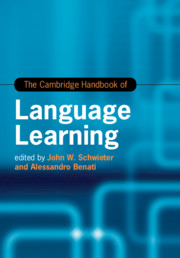Book contents
- The Cambridge Handbook of Language Learning
- Cambridge Handbooks in Language and Linguistics
- The Cambridge Handbook of Language Learning
- Copyright page
- Contents
- Figures
- Tables
- Contributors
- Acknowledgements
- Introduction
- Part I Theories
- Part II Methods
- Part III Skill Development
- Part IV Individual Differences
- Part V Pedagogical Interventions and Approaches
- Part VI Context and Environment
- Part VII Moving Forward
- Index
- References
Part IV - Individual Differences
Published online by Cambridge University Press: 25 June 2019
- The Cambridge Handbook of Language Learning
- Cambridge Handbooks in Language and Linguistics
- The Cambridge Handbook of Language Learning
- Copyright page
- Contents
- Figures
- Tables
- Contributors
- Acknowledgements
- Introduction
- Part I Theories
- Part II Methods
- Part III Skill Development
- Part IV Individual Differences
- Part V Pedagogical Interventions and Approaches
- Part VI Context and Environment
- Part VII Moving Forward
- Index
- References
Summary
Working memory (WM) can be thought of as the limited memory capacity that allows us to hold a very small amount of information (e.g., the several digits of our telephone numbers) in our mind and to simultaneously manipulate this information for completing some cognitive tasks in our daily life (Baddeley, 1986; Cowan, 1988). Since the inception of the seminal WM model by the British psychologists Baddeley and Hitch (1974), the concept has received considerable enthusiasm from multiple subfields of cognitive sciences, spanning from such disciplines as psychology, linguistics, neuroscience, biology, and computer science, to anthropology and philosophy (Miller, 2003; Carruthers, 2013; 2015). Concerted efforts are being poured in continuously from diverse research camps, which subsequently give rise to the propagation of a dozen theoretical models of WM (Miyake & Shah, 1999), notwithstanding lingering debates and controversies over the nature and structure of this key construct of human cognition (e.g., Baddeley, 2012; 2017; Cowan, 2014; 2017).
- Type
- Chapter
- Information
- The Cambridge Handbook of Language Learning , pp. 363 - 474Publisher: Cambridge University PressPrint publication year: 2019



